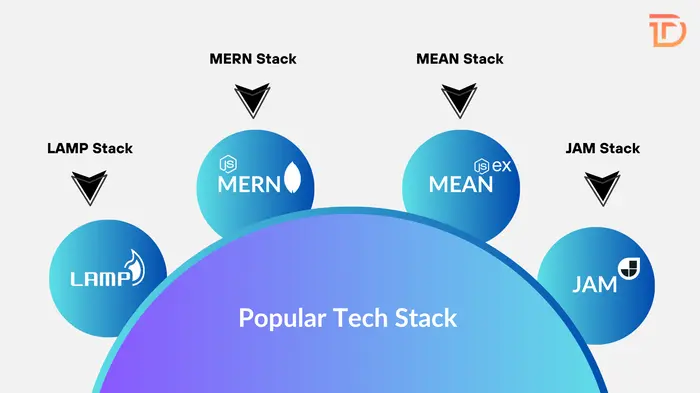Choosing the right tech stack for a software development project is one of the most crucial decisions that determine the project’s success. A tech stack refers to the combination of technologies, tools, and frameworks used to build an application or software. With numerous options available today, selecting the right one can be overwhelming. However, understanding the factors that influence tech stack decisions can simplify the process. In this blog, we will discuss how to choose the right tech stack, focusing on critical considerations like project goals, team expertise, scalability, and long-term maintenance, especially when opting for customized software development services to meet specific business needs.
Understanding Tech Stacks
A tech stack typically consists of two main components: the front-end and the back end. The front-end encompasses everything that users interact with directly on websites or mobile applications, while the back end is responsible for the logic, databases, and server-side functionality. Both layers must work together seamlessly to deliver an efficient and smooth user experience, especially when creating solutions tailored to the unique challenges and goals of new businesses.
Front-end Technologies
The front-end stack includes HTML, CSS, JavaScript, and various frameworks or libraries like React, Angular, or Vue.js. The tools chosen for the front end play a critical role in ensuring the application’s performance, responsiveness, and interactivity. A modern front-end stack should support scalability, performance optimization, and adaptability to user needs.
Back-end Technologies
On the back-end, the tech stack often includes a server, a programming language, a framework, and a database. Popular server-side technologies include languages like Python, Java, PHP, and Ruby, while frameworks such as Django, Flask, and Node.js streamline development. Database choices like SQL (e.g., MySQL, PostgreSQL) or NoSQL (e.g., MongoDB) can significantly impact application performance.
Full-stack Development
Full-stack development refers to using technologies that cover both the front-end and back-end, enabling developers to handle both aspects of the application. Full-stack frameworks, such as the MERN or MEAN stacks, combine JavaScript-based technologies for both front-end and back-end development, simplifying management of a unified tech stack.
Key Factors to Consider When Choosing a Tech Stack

Project Requirements and Goals
Understanding the project’s goals is the first step in selecting the right tech stack. Small-scale projects with minimal features may require simpler technologies, while larger applications with complex functionality may demand more robust solutions. A lightweight website or a basic mobile app may benefit from a simpler stack, whereas a high-performance application that handles large amounts of data will require more powerful technologies. For more advanced applications, it’s important to choose a stack that supports specific functional requirements, scalability, and future growth.
Team Expertise
The expertise of your development team is crucial when selecting a tech stack. Every technology has its own learning curve, and choosing one outside your team’s experience can lead to slower development, increased costs, and potential problems. If your team is familiar with a particular language or framework, sticking to that option may simplify the process. However, balancing familiarity with project needs is essential. New technologies may provide substantial benefits, but they may require time for the team to learn, potentially delaying progress. Striking a balance between what the team knows and what the project demands is key.
Scalability and Flexibility
Scalability refers to the ability of a tech stack to handle increasing demands as the application grows. When making a decision, consider how well each technology can scale to accommodate higher traffic, more users, or more complex functionality. Scalable tech stacks are designed to evolve as a project expands, ensuring that performance is maintained even as usage grows. Flexibility is another crucial factor. Over time, user needs and business priorities may change. A flexible tech stack allows for easy updates and the addition of new features without a complete overhaul of the system. Choosing a stack that is both scalable and flexible ensures long-term success.
Speed of Development
Speed of development is a key consideration when choosing a tech stack. Some technologies are designed for rapid development and offer a wealth of pre-built modules, making it easier to get an application up and running quickly. If you have tight deadlines, opting for a stack that prioritizes speed can be beneficial. However, be mindful of the trade-off between speed and quality. Quick development shouldn’t come at the expense of long-term maintainability or performance. Strive to select a stack that allows for efficient development without sacrificing the overall integrity of the application.
Community Support and Documentation
A strong community can make a big difference when selecting a tech stack. A popular technology often has a vibrant community of developers, forums, tutorials, and documentation that can help address issues and provide insights. The quality of documentation should not be underestimated—it can significantly impact your team’s ability to implement and use a tech stack effectively. Choosing a stack with excellent community support ensures that developers can troubleshoot problems, share best practices, and improve their development processes.
Security Considerations
Security is a critical factor when selecting a tech stack. A good tech stack should come with built-in security features or support easy integration with third-party security tools. Ensure that the stack you choose provides robust security for encryption, user authentication, and data protection. For applications that handle sensitive data, such as personal or financial information, it’s especially important to choose a stack that adheres to security standards and supports various security protocols. A lack of security features could expose the application to vulnerabilities.
Budget and Resources
Every software project has a budget, and selecting the right tech stack can impact costs. Some tech stacks are open-source and free, while others may require licensing fees. Additionally, the complexity of the stack can affect development costs, as certain technologies may require specialized developers, leading to higher labor expenses. It’s essential to evaluate the total cost of ownership, including initial development, long-term maintenance, and future upgrades. A more expensive tech stack might be worth the investment if it offers scalability, security, and flexibility that align with the project’s long-term goals.
Popular Tech Stack Choices and Their Benefits
When it comes to choosing the right stack, many options are available. Here are a few popular tech stacks and the types of projects they are best suited for:

LAMP Stack
The LAMP stack (Linux, Apache, MySQL, PHP) is a reliable and cost-effective option for small to medium-sized projects. Its open-source nature makes it accessible for businesses on a budget. LAMP is commonly used for web development projects that don’t require extensive custom features but still need reliable performance.
MERN Stack
The MERN stack (MongoDB, Express.js, React, Node.js) is an excellent choice for full-stack JavaScript development. It allows developers to work exclusively with JavaScript, simplifying development. MERN is ideal for building real-time applications and single-page applications that require high interactivity.
MEAN Stack
The MEAN stack (MongoDB, Express.js, Angular, Node.js) is another JavaScript-based full-stack option. Angular provides structure for large-scale applications with complex features. MEAN is particularly suitable for enterprise-level applications requiring scalability and robust architecture.
JAM Stack
The JAM stack (JavaScript, APIs, Markup) is an architecture designed for fast, secure websites and web applications. It focuses on decoupling the front-end from the back-end, relying on static files and APIs to deliver performance and speed. JAM stack is ideal for content-heavy websites and e-commerce platforms that need to load quickly.
The Bottom Line
Selecting the right tech stack is a pivotal decision that can determine the long-term success of your software development project. It is essential to evaluate factors such as project requirements, team expertise, scalability, security, and budget. Understanding these considerations ensures that you choose a tech stack that not only supports the current needs of the project but also provides the flexibility to grow and evolve. For businesses seeking tailored solutions, leveraging custom web development services can be a game-changer, offering flexibility and precision in meeting unique project demands. The key to success is balancing immediate requirements with long-term goals. The right tech stack will empower your team to build a high-quality, scalable, and maintainable application, setting the foundation for future success.
If you’re looking for expert guidance in choosing and implementing the right tech stack for your next project, Dreamer Technoland offers custom software development services tailored to meet your unique needs. With a skilled team of developers and a proven track record in creating scalable and secure software solutions, Dreamer Technoland can help bring your ideas to life. Whether you need a robust enterprise solution, a user-friendly mobile app, or a dynamic web platform, we have the expertise to deliver high-quality software that drives business success. Our solutions are designed to seamlessly integrate with your digital business technology platform, enhancing efficiency and supporting your growth. Reach out to Dreamer Technoland today to discuss how we can help build the perfect tech stack for your project and ensure your vision becomes a reality!



